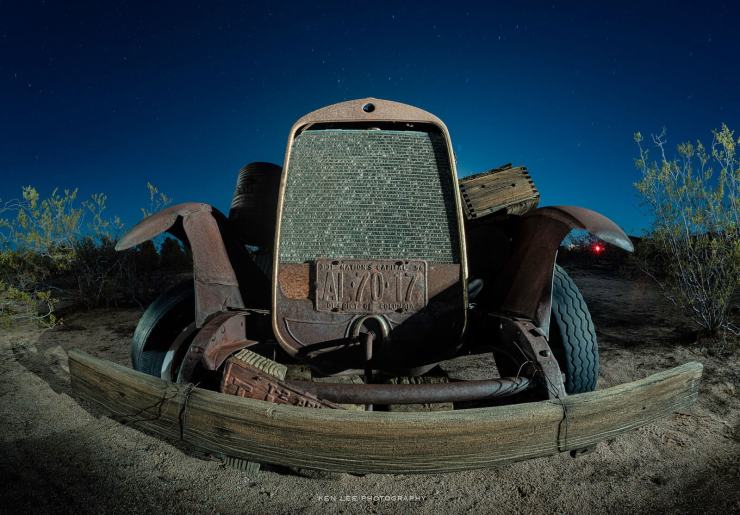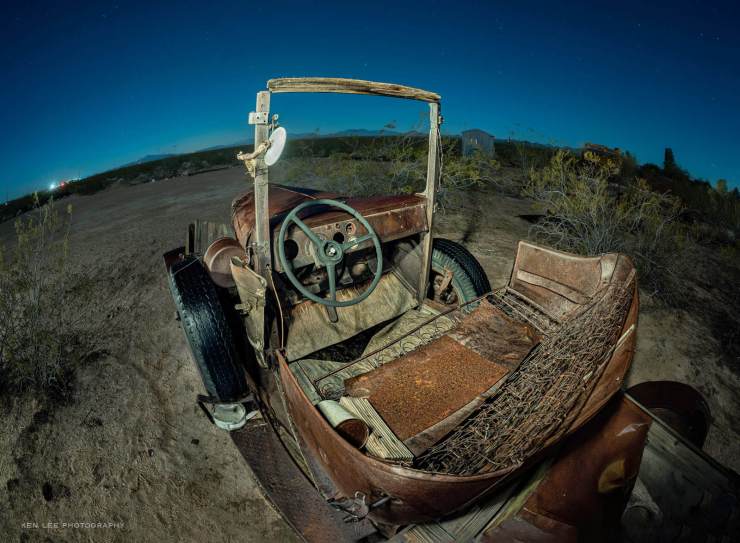High-quality LED light painting flashlights are challenging to find at any price. Can you find one for under $30? I tried to find out.

Six features I wanted for a light painting flashlight
I wanted a lot out of a flashlight for light painting but without laying out a lot of cash. There were six features that I decided were very important.
1. Warm white LED
I wanted a high-quality warm white light. Using the ProtoMachines LED2, I always had a slightly warm light and felt that it was more flattering than colder white lights. Flashlights are often measured in Kelvin. A flashlight with warm light is generally between 3000K to 4000K.
2. Natural light and detail with a CRI greater than 90
“CRI” stands for “Color Rendering Index.” It’s a measurement of how natural colors render under artificial white light as compared to sunlight. It’s measured on a scale of 0 to 100. The closer to 100, the truer colors should look under its light. Generally, a CRI of 80 and above is considered good for a flashlight. I wanted one that was north of 90.
3. Easily rechargeable via USB

I had enough batteries to take in and out of devices. I felt that if I could have a flashlight that I could simply recharge without having to remove batteries, that would help ease the workflow a little.
4. Adjustable brightness

The reason for this is probably self-explanatory. I don’t want the same brightness all the time when I am light painting. I was hoping to find a light with at least four brightness levels. If I could find a flashlight that ramped its brightness, that might be even better.
5. Small size
I already had some light including the ProtoMachines. And of course, I want to save space. Keeping the flashlight in my pocket would also be a bonus. Thankfully, this was the easiest of the features to find.
6. Under $60
I didn’t want to spend too much money on a backup light painting flashlight. I set my purchase price at a maximum of $60, although I preferred it lower than that.
Searching for the light
I read about several flashlights. This included the Convoy M3-C GT FC40 high CRI flashlight. This was a slightly chunky flashlight that seems to be revered by flashlight enthusiasts. However, the shipping was 3-4 weeks, and I was going on a trip in less than two weeks. That was unfortunately out. Too bad. It was about $40-45 and seemed to meet all the requirements.
Several of my friends use Coast HP7R or HP5R flashlights. These didn’t meet all my parameters. For instance, they only had two brightness settings: high and low. However, they did have a handy zoom feature for controlling the width of the light. However, both lights were over my $60 limit. I made a mental note to myself that this could be a very complementary flashlight to what I was looking for.
I read about other flashlights, such as Thrunite TC20 V2, Nitecore and Skilhunt, but they were often a little higher than my budget allowed.
Could Wurkkos work as my workhorse light?
Somehow, I stumbled upon the Wurkkos FC11 pocket LED flashlight. This has a high CRI of 90, was 1300 lumens, could be charged via USB-C, and had a warm white light (4000K). To my surprise, it sold for under $30 on Amazon. Amazingly, in one mode, it also offered brightness ramping! Even in the default mode, it had four brightness settings. It also had a Turbo Mode, where the little flashlight roars into action, throwing out a blinding 1300 lumens of bright light. I would probably not ever need this for light painting, but it’s cool to know that I can now be seen from outer space.
The Wurkkos FC11 uses a highly-regarded Samsung LH351D high CRI emitter. It’s also waterproof. It has a rating of IPX 7, which means that I could dunk this in water up to one meter. Good to know in the highly unlikely event that I drop it in a bottle of Gatorade.
I ordered it the next day.
Light painting with the Wurkkos FC11

I met up with my friend Tony Donofrio at the Mojave Desert Heritage and Cultural Association along historic Route 66 in Goffs, CA. They have an amazing outdoor museum full of cars, trucks, ten-stamp mills, equipment, Western-style wooden buildings, smelters, and many more historic items from yesteryear. In short, it’s night photography light painting paradise.

The Wurkkos FC11 was immediately a joy to use. You could immediately see an amazing amount of detail in anything that it illuminated. The “throw” of the light was wide, but not too wide for light painting. Also, it was even throughout, not having any real hot spots in the center to mar any light painting. It was also nice and small. Having the ability to ramp the brightness was also amazing. The flashlight remembers the last setting, so I could retain consistency.
The results were beautiful. I looked at the screen at the back of my camera and smiled. I had another flashlight to augment the ProtoMachines.
Two minor challenges in the field
I encountered two minor challenges. Both are probably things that you could chalk up to getting used to a new flashlight.
I loved the ramping feature. While the ramping was a little fast, I could dial in the brightness I wanted. Still, I found myself wishing that the ramping were about half as fast.
The other challenge was that several times, I clicked on the button several times to turn it off, only to find that it remained on. However, I’ve since used the flashlight several more times, and this has never happened again. I’m not sure what happened. I’m willing to chalk this up to some inadvertent operator error.
Working with the Wurkkos
I used the Wurkkos light for the rest of the evening. Although I didn’t always use it for light painting since I already had the ProtoMachines, I did use it for many other things. This included illuminating the subject so I could use autofocus as well as general flashlight use. It’s very compact size meant that I could easily keep it with me at all times.

As a bonus, it has a surprisingly strong magnet. I’m not really sure what I would use this for at this moment, but it’s good to know that it’s there if I need it.
I love the ProtoMachines. It produces many different colors and has extremely high-quality light. But it’s also in very short supply and typically sells for over $450. That a $30 flashlight can keep up with it when using the color white is astounding. This also shows how much LED flashlights have advanced in the last 10 years. Despite the two little hiccups I experienced briefly, I feel that this is an excellent purchase. I will be keeping the light around for just about everything.
Do you have a favorite flashlight for light painting? What do you like to use to illuminate subjects at night? Please share in the comments!
Tell your story with the second annual Visual Storytelling Conference!
Experience four days of interactive, online training sessions featuring a range of educational content with experienced photographers and content creators. This free event kicks off with a series of technical boot camps to build essential skills, followed by live, online sessions on photography, video, business and social media. Join live from March 10-13, 2022!
